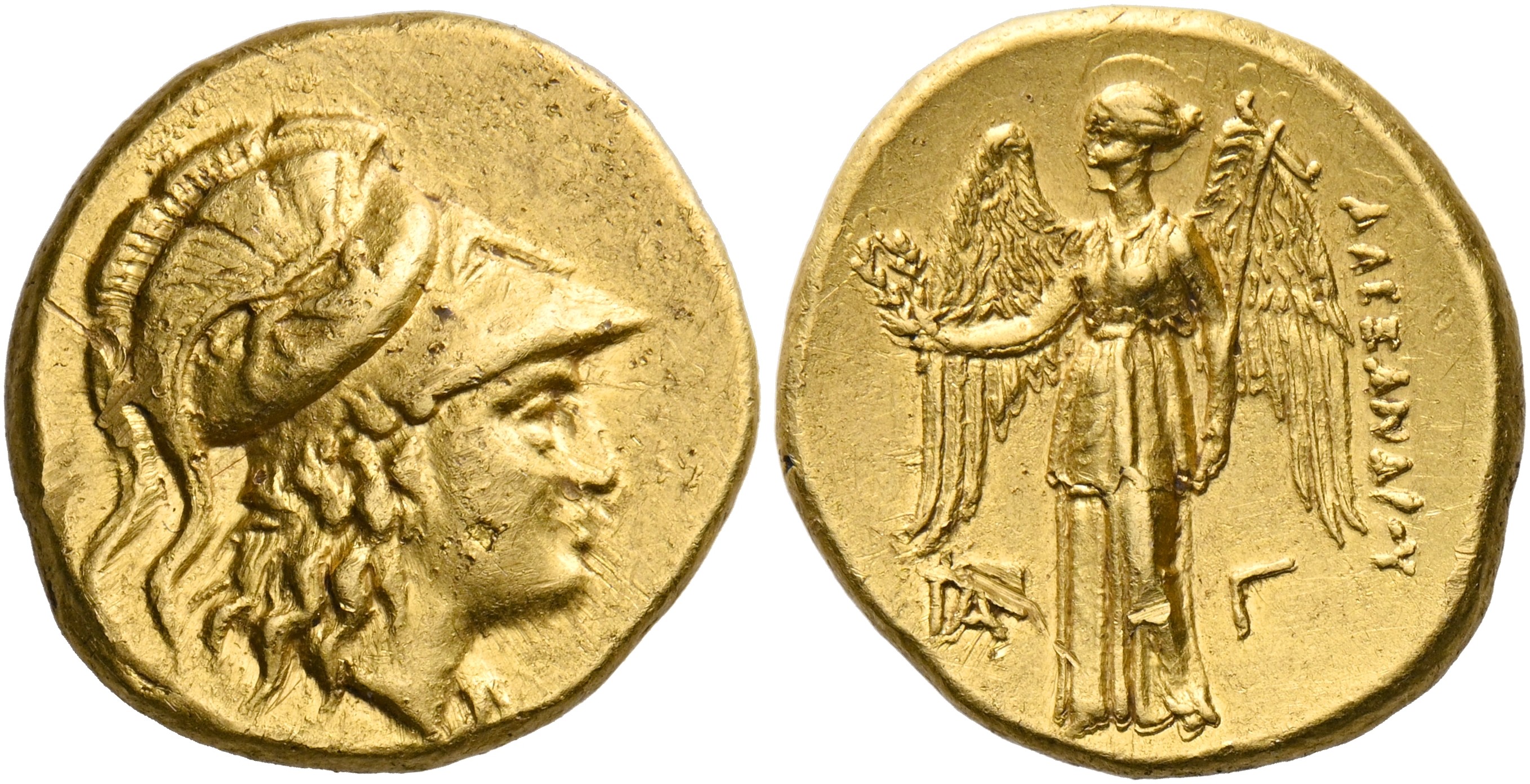S 1743 - Salamis (Demetrius Poliorcetes), gold, staters (306-295 BCE)
From SILVER
306 BCE - 295 BCE Gold 14,379 kg
Description
| ObverseInscription or printing placed on the obverse.: | Head of Athena to right, wearing a Corinthian helmet adorned with a griffin |
| ReverseInscription or printing placed on the reverse.: | ΑΛΕΞΑΝΔΡΟΥ (Greek).Nike standing left with her wings spread, holding laurel wreath in her right hand and stylis in her left, in left field, monogram of ΠΑ, in right field, Γ |
Mint and issuing power
| MintIdentifies the place of manufacture or issue of a numismatic object.: | Salamis | Ancient regionAncient region.: | Cyprus | Modern countryModern country: Turkey | AuthorityIdentifies the issuing power. The authority can be "pretended" when the name or the portrait of X is on the coin but he/she was not the issuing power. It can also be "uncertain" when there is no mention of X on the coin but he/she was the issuing power according to the historical sources: | Alexander III the Great (Argead king, 336-323 BC), Demetrius I Poliorcetes (Antigonid king, 294-283 BC) |
Chronology
| FromIdentifies the initial date in a range assigned in a numismatic context. | 306 BCE | toIdentifies the final date in a range assigned in a numismatic context.. | 295 BCE | PeriodTime period of the numismatic object.: Hellenistic 323-30 BC |
Physical description
| MetalThe physical material (usually metal) from which an object is made.: | Gold |
Median weightMedian of the weights of numismatic objects (in grams). in grams | 8.60 | DenominationTerm indicating the value of a numismatic object. Examples: tetradrachm, chalkous, denarius.: | stater |
StandardStandard.: | Attic |
Image

S1743 Salamis gold Demetrius Alexander.jpg [1]
References
| Die study referencePublication of the study: | Newell 19271Newell 1927 | ||
| Coin series referenceReference to coin series study: | Sear II2Sear II, n° 6757-6758, RQEMH3RQEMH, n° 126 | ||
Obverse dies distribution
| FrequencyFrequency of specimen in distribution. ᵖ | Number of obversesNumber of obverse dies. ᵖ (o) | % (o) | Number of coinsNumber of coins. (n) | % (n) | Die nameName(s) of the die(s). |
| 1 | 4 | 66.67 | 4 | 26.67 | A, C, D, F |
| 3 | 1 | 16.67 | 3 | 20 | E |
| 8 | 1 | 16.67 | 8 | 53.33 | B |
| Total | 6 of 6 | 100.01 | 15 of 15 | 100 |
Reverse dies distribution
no distribution is available
Quantification
| Number of obversesNumber of obverse dies. ᵖ (o) | 6 | Number of singletons (o1)The number of singleton coins. ᵖ | 4 |
| Number of reverse diesNumber of reverse dies. (r) | Number of coinsNumber of coins. (n) | 15 | |
| Coins per obverse dieNumber of coins per obverse die. (n/o) | 2.5 | Coins per reverse dieNumber of coins per reverse die. (n/r) | |
| Reverse per obverse ratioRatio of obverse dies divided by reverse dies. (r/o) | Percentage of singletons (o1)number of coins (n) divided by the number of singletons (o1) ᵖ | 66.67 % | |
| Original number of dies (O) (Carter 1983 formula)The estimation of the number of coins according to Carter 1983 ᵖ | 8.36 | Coins struck if 20,000 as average productivity per dieCoins made if the average productivity for obverses (according to Carter) is 20,000. ᵖ | 167,200 |
| Original number of dies (O) (Esty 2011 formula)The estimation of the number of coins according to the singleton formula in Esty 2011 ᵖ (O) | 10 | Survival rate if 20,000 as average productivity per dieSurvival rate if average productivity is 20,000. ᵖ | 0.00009 |
| Coverage (o = % of O) (Esty 1984 formula)Esty 1984 - coverage (% of O) ᵖ (o = % of O) | 73.33% | Die productivity if survival rate 1/2,000Average productivity if survival rate is 1/2,000. ᵖ | 3,588.52 |
| Weight of silver (in kg) if 20,000 coins per die (O = Carter formula)Carter 1983 * Median weight * 20000 (*10 if gold or electrum) ᵖ | 14,379 kg <br /> 14,379 kg | Die productivity if survival rate 1/5,000Average productivity if survival rate is 1/5,000. ᵖ | 8,971.29 |
Remarks
Most likely one single workstation
References
- ^ Newell, Eward T. (1927), The Coinages of Demetrius Poliorcetes, London, ix, 174 p., 18 pl.
- ^ Sear, David R. (1979), Greek coins and their values. Vol. II, Asia and North Africa, London, xlviii, p. 317-762
- ^ Callataÿ, François de (1997), Recueil quantitatif des émissions monétaires hellénistiques, Numismatique Romaine, Wetteren, X + 341 p.